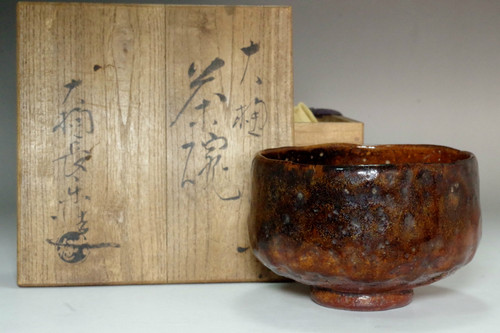Ohi Choraku (1902-1991) Vintage tea bowl in ohi ware #4081
- SKU:
- 4081
- Shipping:
- Free Shipping
- width: approx. 11cm (4 21⁄64in)
- height: approx. 7.5cm (2 61⁄64in)
- weight: 317g (gross 564g)
- condition: small damaged (see pictures)
He is a direct descendant of Ohi Chozaemon 7th Michitada.
Ohi-ware
In Genbun 6 (1666) Tsunanori, the fifth of the Maeda line and daimyo of the Kaga Domain, wanted to promote tea culture and invited the 4th head of the Uransenke school of tea ceremony, Senso (Soshitsu Sen), to be the tea ceremony magistrate. At that time Senso was accompanied by a potter and tea bowl master, Chozaemon, who was the best student of the 4th head of the Raku line, Ichinyu.
Chozaemon was searching for the best potter's clay and upon discovering it in Ohi village in Ishikawa prefecture, he continued living and making pottery there in Kaga. He then took the surname Ohi from the village and it continues to be used to this day.
Ohi- ware is "Wakigama" (which is a general term for kilns used to make Raku-ware that are outside of the Raku line) of the Kyoto Raku line. Raku-ware has spread throughout Japan since the Meiji period, but in terms of makers who have directly inherited the Raku line techniques, Ohi-ware is said to be the only current Wakigama with such lineage.
Fine quality earth is coated with a red-yellow glaze, commonly known as Ohi Amber glaze, and fired at a low heat of 750-850 degrees. Ohi-ware is defined by the brilliant reddish-brown luster of the bowls' surface created by using the Amber glaze.
Two Ohi-ware Kilns
Ohi-ware was produced by the direct descendants of Ohi Chozaemon and his disciples from the time Chozaemon opened his business in Kanazawa until Ohi Chozaemon the 7th Michitada, who died in 1872.
The production of Ohi-ware ceased with the decline of the tea ceremony at that time, and Ohi Chozaemon the 7th Michitada was the last person to produce Ohi-ware. Since then, as a result of the enthusiastic work of the disciples and their descendants, Ohi-ware has come to be known throughout the country.
As mentioned above, the production of Ohi-ware by direct descendants ceased after Ohi Chozaemon the 7th Michitada's death because his eldest and second sons did not engage in the family business and left home. It is said that the production of Ohi-ware had a difficult time due to the decline of the tea ceremony at that time. Later, Nara Rikichi, a disciple of Michitada, revived Ohi-ware and took the name of Ohi Chozaemon the 8th. After that, Rikichi’s eldest son took the name of Ohi Chozaemon the 9th, and the eldest son of the 9th took the name of Ohi Chozaemon the 10th in 1987 (Showa 62).
On the other hand, the tea ceremony, which had been in decline, flourished again and demand for Ohi-ware increased in the Showa period (1926-1989). Ohi Choraku (1902-1991), a direct descendant of Ohi Chozaemon 7th Michitada, also revived Ohi-ware. His eldest son was named Ohi Chozaemon 9th Kanbei.
As you can see, there are two types of Ohi-ware families, one inherited by a disciple and the other revived by direct descendants, and both sides are fighting over the right to call themselves "Ohi-ware original" and "Ohi Chozaemon the 10th” in the court.
The Claim by Descendants of the Disciple
When the "descendants of the disciple" were sued by the "direct descendants" to prohibit the use of the name "Ohi Chozaemon the 9th", a settlement was reached. "Descendants of the disciple" issued a pledge stating that it had taken over the Ohi-ware brand, Nara Rikichi became the eighth generation by taking over the brand name Ohi Chozaemon and his son became Ohi Chozaemon the 9th then they paid 2,000 yen to the "direct descendants". The "descendants of the disciple" claims to be the rightful inheritor of Ohi-ware on the basis of the payment.
In other words, the "descendants of the disciple" claimed that they had paid a large sum of money to buy the brand name Ohi Chozaemon at that time and the business rights had been settled.
The Claim by Direct Descendants
The Ohi family and "descendants of the disciple" are strangers who have no blood relationship. It is argued that the settlement is valid for one generation only and any future succession to the brand name "Ohi Chozaemon" must be approved by the Ohi family’s direct descendants.
The Court's Opinion
Regarding “descendants of the disciple”,
After the death of Ohi Chozaemon the 7th Michitada, “descendants of the disciple” purchased the family tree and pottery seal of the Ohi family from the “direct descendants”, who were living in poverty, but it cannot be proved that “descendants of the disciple” were given the brand name of Ohi-ware. Therefore, it should be said that it lacks a legal basis to claim that “descendants of the disciple” is a legitimate family that succeeds in the brand name as the Ohi Chozaemon.
Regarding “direct descendants”,
Even though they are direct descendants of Ohi Chozaemon, they had never succeeded to the business, it is not permissible to claim that “direct descendants” succeeded to the brand name Ohi Chozaemon.
Therefore, Ohi-ware, whose founder was Ohi Chozaemon the First, was abolished by Ohi Chozaemon the 7th Michitada. In short, although "descendants of the disciple" and "direct descendants" profess to be successors to the brand name Ohi Chozaemon, there is no legitimate basis for their claim.
As a result, a settlement was reached. In 1993, ”direct descendants” changed their brand name from "Ohi Chozaemon" to "Ohi Kanbei".
However, there was a dispute again when the "direct descendants" expressed that Ohi Chozaemon, the successor of Ohi-ware, would be renamed to Ohi Kanbei.
The court ruled that the "descendants of the disciple" should trade as "Ohi Chozaemon" and "direct descendants" should trade as "Ohi Kanbei" and that they could not infringe on each other's brands.





















